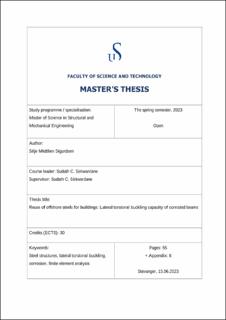| dc.description.abstract | The building industry is responsible for a lot of today’s CO2 emissions. The emissions from the building industry can be reduced by reusing steel from offshore structures. However, there are several challenges related to reusing steel. Offshore structures are subjected to a harsh environment, and corrosion is a significant cause of failure. Corrosion causes material loss, and this will reduce the cross-sectional properties and the bearing capacity. The risk of lateral torsional buckling (LTB) of open cross-sections increases due to material loss. Thus, there need to be more studies on the simulation of the reduced LTB moment capacity of open cross-sections.
The main objective is to study how the remaining LTB moment capacity of I-sections is affected by various corrosion scenarios, and to provide analytical framework for I-sections with varying cross-sections due to corrosion. Analytical LTB moment capacities of the considered beams are compared with those obtained from a linear finite element (FE) analysis. The buckling reduction factor (𝜒𝐿𝑇) versus non-dimensional slenderness (𝜆̅𝐿𝑇) is plotted for eight different beam lengths subjected to various corrosion scenarios. The elastic buckling moment and LTB moment capacity are obtained for each beam in the linear FE analysis, and a plot of the applied moment versus lateral deflection for one beam is provided.
The LTB moment capacities for beams with a constant cross-section obtained from the linear FE analysis is more conservative than the analytical LTB moment capacities. If the length of the corroded section of the beam is reduced, the LTB moment capacity will increase. Some of the shortest beams are subjected to local plate buckling. As a result, the LTB moment capacity of these beams deviates from the results obtained in the analytical approach. For a 15 m long IPE300 beam subjected to 1.41 mm thickness reduction around the entire cross-section, the LTB moment capacity is reduced by 51%. If only 1/3 of the beam length is subjected to the same thickness loss, the LTB moment capacity for the same beam is reduced by 21%. | |
